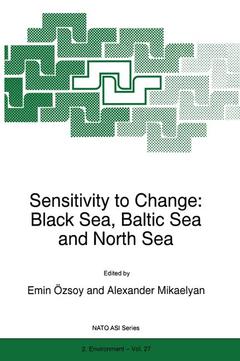Preface. A Synopsis and Recommendations for Future Studies. Changes of Mean Sea Level and Ice Conditions in Gdynia as Indicators of Climate Changes in the Gulf of Gdansk; M. Sztobryn, et al. Variability of Northwestern Black Sea Hydrography and River Discharges as Part of the Global Ocean-Atmosphere Fluctuations; A. Polonsky, et al. Recent Man-Made Changes in the Black Sea Ecosystem; Yu.P. Zaitse, B.G. Alexandrov. Seasonal and Long-Term Variability of the Black Sea Optical Parameters; V.L. Vladimirov, et al. The Nutrient Stock of the Romanian Shelf of the Black Sea During the Last Three Decades; A. Cociasu, et al. Distribution and Fluctuation of Dominant Zooplankton Species in the Southern Black Sea in Comparison to the North Sea and Baltic Sea; U. Niermann, W. Greve. Some Aspects of Phytoplankton Long-Term Alterations off Bulgarian Black Sea Shelf; S. Moncheva, A. Krastev. Sensitivity to Anthropogenic Factors of the Plankton Fauna Adjacent to the Bulgarian oast of the Black Sea; A. Konsulov, L. Kamburska. Long-Term Variability of Phytoplankton Communities in Open Black Sea in Relation to Environmental Changes; A.S. Mikaelyan. Mnemiopsis Leidyi Abundance in the Black Sea and Its Impact on the Pelagic Community; T.A. Shiganova. Seasonal Variation of Surface Pigment Distribution in the Black Sea on CZCS Data; N.P. Nezlin. The Effect of Hydrological Conditions on the State of Herring Stocks in the Baltic Sea; T. Raid. Role of Fishing in the Black Sea Ecosystem; A.C. Gücü. Environmental Impact on Fish Resources in the Black Sea; K. Prodanov, et al. Variations in the Vertical Structure of Water Chemistry within the Three Hydrodynamically Different Regions of the Black Sea; Ö. Bastürk, et al. Spatial Isopycnal Analysis of the Main Pycnocline Chemistry of the BlackSea: Seasonal and Interannual Variations; S. Konovalov, et al. Suspended Matter as an Index of Productivity in the Western Black Sea (Application for Productivity and Eutrophication Control); S.V. Vostokov. Particulate Organic Matter of Black Sea Euphotic Zone: Seasonal and Long-Term Variation of Spatial Distribution and Composition; Z.P. Burlakova, et al. Time-Series Profiles of 134Cs, 134Cs and 90Sr in the Black Sea; K.O. Buesseler, H.D. Livingston. Physical Oceanography Variability in the Black Sea Pycnocline; L.I. Ivanov, et al. The Black Sea Bottom Homogeneous Layer: A Simple Model of Formation; V.N. Eremeev, et al. Physical Processes of Surface-Deep Layers Exchange in The Black Sea; E. Demirov, et al. Convection in the Baltic Sea: A Numerical Process Study; J.O. Backhaus, H. Wehde. An Ice/Ocean Model for North and Baltic Sea; C. Schrum. Quantification of Transports to Skagerrak: A Modeling Approach; M.D. Skogen, et al. Eddy Dynamics Controlled by Basin Scale, Coastline and Topography; N.H. Rachev, E.V. Stanev. Seasonal Variability of the Black Sea Climatic Circulation; D.I. Trukhchev, R.A. Ibrayev. Cold Intermediate Water Formation in the Black Sea. Analysis on Numerical Model Simulations; J.V. Staneva, E.V. Stanev. Circulation in Semi-Enclosed Seas Induced by Buoyancy Flux Through A Strait; G.K. Korotaev. Modelling of Strait Dynamics: The Baltic Experiments; E. Sayin. Heat and Salt Intrusions in the Pycnocline from Sinking Plumes. Test Case for the Entrainment in the Black Sea; J.A. Simeonov, et al. Coastal Eutrophication of the Southern Bight of the North Sea: Assessment and Modelling; C. Lancelot, et al. Modelling the Functioning of the North-Western Black Sea Ecosystem from 1960 to Present; D. van Eeckhou




